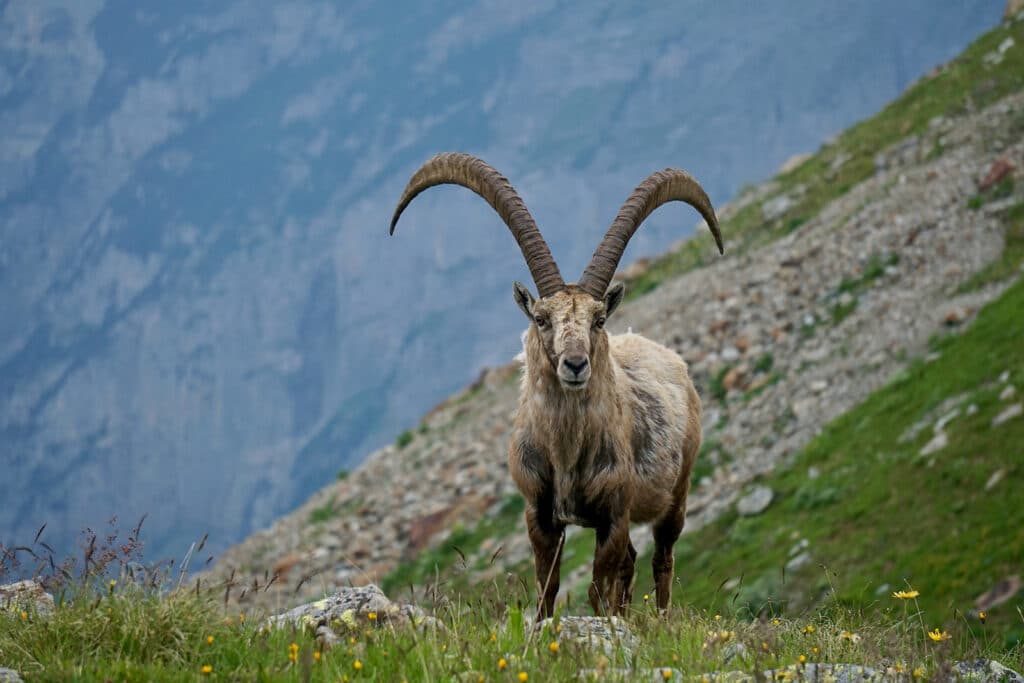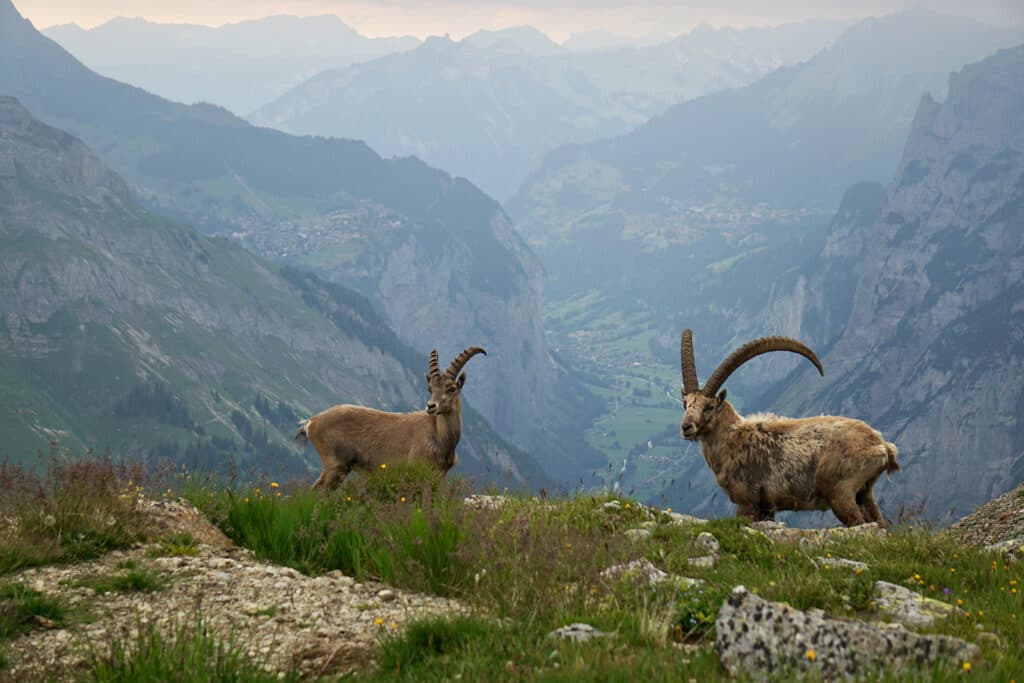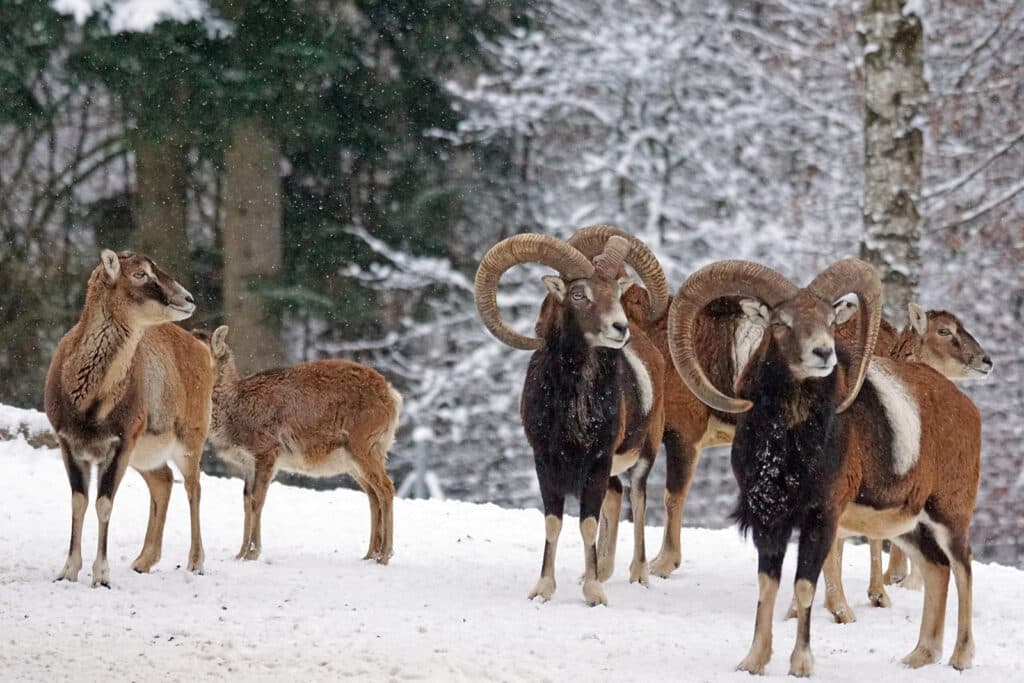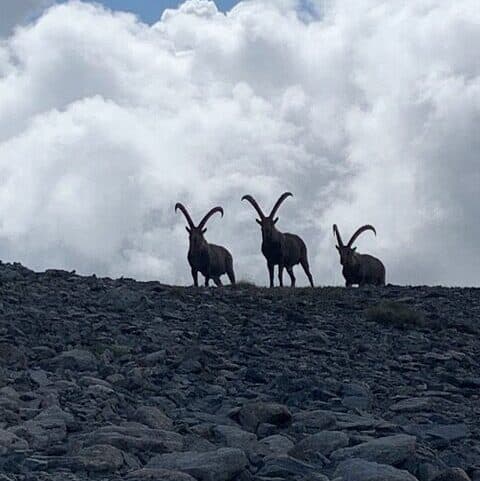

Ibex, chamois, mouflon & deer in the Alps: What just ran by?
Top image: Coline Paquereau
My first encounter with an ibex is still, years later, one of my favorite memories from my life here in Chamonix. I was spending the weekend dog-sitting Izzy, Run the Alps’ Ambassador of Joy, and took her on a hike to calm her endless energy. It was early spring, and mounds of wet snow were slowly melting. As we walked along, my mind wandered, the way it does when hiking. I wasn’t thinking about anything in particular or even paying much attention to where I was going. I watched Izzy bound along the trail ahead of me, pulling to the limits of her leash, joy exuberating from her every fiber.
Out of nowhere, an ibex appeared in front of us, stepping silently onto the path and locking eyes with mine, stopping me in my tracks. At that moment, I had no idea what I was encountering. My focus was on its large, curved horns, while my mind raced with uncertainty. We stood there, staring at each other. The ibex showed no fear–neither of me nor of the dog, who was making feeble attempts to get the ibex to play, convinced she had just found a new best friend. The ibex did not return the sentiment.

I stood in frozen panic as the ibex stared into what felt like the depths of my soul. He exuded an almost unnerving confidence, standing his ground without a hint of fear. The entire stare-down lasted almost 10 minutes, during which time he did not blink. Not even once.
I was transfixed by his beauty, and yet I couldn’t shake the thought that at any moment, he might pick me up with his horns and throw me down the side of the mountain. As a trail runner born far, far away from mountains, I suddenly realized how little I knew. What was this creature? Why were its horns so big? What other animals were out there? And, most importantly–did they eat dogs?
Ibex
I later found out that the ibex is also known as a Steinbock in German, and le bouquetin in French. In layman’s terms, it’s also known as a wild goat or the King of the Mountain. Its scientific name, Capra ibex, classifies it as an alpine ungulate—a fancy word for a hoofed animal that lives in the Alps. Other alpine ungulates include chamois, mouflon, red deer, and roe deer–species perfectly adapted to the rocky, steep terrain of the French Alps and that, to the untrained eye, all look similar from a distance.
It is easy to spot an ibex. They are hefty mountain goats, weighing anywhere from 150 to 270 pounds, covered in thick brown hair, carry enormous horns, and specialize in defying gravity. They have been seen scaling nearly vertical rock faces, balancing on tiny ridges just centimeters wide, and leaping over gaps with unthinkable precision. (Watch them here.) Their secret? Suction cup-like feet that allow them to grip rocky surfaces securely. In other words, ibex have what would be a trail runner’s dream shoe? I’d wear it! (Hint, hint Hoka!)
The longer I stood face to face with the ibex, the more I realized he was unlikely to budge. I would have to make the first move if Izzy and I wanted to get off the mountain and back home before, say, a week had passed.
I decided the best course of action would be to walk slowly around him, giving him ample room so he would not feel threatened.
While the plan seemed sound in theory, its execution was flawed. With a huge dropoff on my right the only option was to maneuver to the left–which meant climbing uphill to move around him. And this is where my real lack of understanding of ibex began to show. When confronted with danger, an ibex doesn’t flee–its first instinct is to gain height. As I stepped higher, the ibex matched each of my steps, blocking my passage with his massive body. If I had encountered a chamois or deer, they would have vanished in an instant. It turns out, however, that ibex don’t flee. Instead, they whistle and huff to let you know to keep your distance.

This lack of fear of humans, coupled with their unique beauty and a large set of horns that adorn their heads, have made them both easy and prized targets for hunters throughout history. While both sexes have horns, it is the male’s horns that are most sought after—growing continuously throughout their lives into a distinctive sickle shape marked by prominent ridges. Ibex horns can reach up to three feet in length and were once believed to have medicinal properties, including curing impotence, while ibex blood was thought to alleviate kidney stones. By the early 19th century, relentless hunting had pushed them to the brink of extinction.
Ironically, it was Victor Emmanuel II, the King of Italy and an avid ibex hunter, who played a crucial role in saving the species—not only for conservation, but to preserve his beloved pastime. Concerned about the dwindling ibex population, he established a hunting reserve in 1856. This protected area allowed him to continue hunting while also fostering population recovery. Confined to the reserve, the ibex population rebounded in captivity, eventually serving to reintroduce the species throughout the Alps. Ibex are now classified as a “species of least concern,” meaning they are abundant in the wild. However, their near-extinction caused a population bottleneck, making inbreeding their greatest ongoing threat.
Chamois

Not to be confused with the ibex, the chamois tend to be the ones that look like a blur of fur, dashing off in the distance at the first sound of human presence. The chamois is a species called a “goat-antelope,” which means, of course, that it looks a little like both animals. While the height difference between ibex and chamois is only a matter of inches, the chamois is significantly less robust, and is almost half the weight of an ibex. Like ibex, they have curved horns–but the horns are much smaller, growing on average up to 12 inches in length. Perhaps the easiest way to identify the chamois is by its facial markings–stripes of dark and white fur–and a dark stripe along its back.
Looks aside, chamois are the ultimate mountain athlete—the embodiment of what we trail runners aspire to be. They are incredibly agile, effortlessly navigating steep, rocky terrain with precision and grace. In addition to their nimbleness, they are also remarkably powerful, capable of reaching speeds of up to 30 miles per hour and leaping over six feet in a single bound. Perhaps most envy-inducing of all is their sheer climbing ability—they can climb 3,300 feet (1,000 meters) in just 15 minutes. Check out this video to see them in action–it’s ridiculous!
Mouflon

The mouflon is one of the few alpine ungulates whose horns rival the impressive stature of the ibex. To distinguish between ibex and mouflon, look for horns that curve downward below the face rather than arching high into the air. These wild sheep are not native to the Alps but were introduced from the Mediterranean islands of Corsica and Sardinia, originally as bait for bears and wolves that were preying on domestic flocks. Over time, they established a stable presence in the Alps. Today, they are found in the Swiss Alps, particularly in the Chablais region and the Valais canton, where they were introduced from France in the 1970s and 1980s. Their populations have since flourished, with over 300 in Chablais and 200 in Valais.
In Italy, they can be found throughout the Dolomites, specifically in the Dolomiti Bellunesi National Park. They prefer high-mountain pastures and shrubby areas, where you can find them eating grasses and other alpine plants.
They are easy to spot, with reddish-brown coats, white markings on their sides and muzzle, and large horns. You may also come across bachelor herds, as males and females live in separate groups outside of the mating season. Each autumn, during the rut, males leave their bachelor herds to compete for mates, engaging in head-to-head clashes to establish dominance. After the breeding season, they return to their all-male groups, while females remain in matriarchal herds with their young.
Deer

Alpine deer can easily be confused with chamois, as their bodies are similar in stature and color. There are two types that are found throughout the Alps–the red and roe deer. Of the two, the red deer is larger, resembling the North American elk. Males have large, branching antlers and a coat that turns reddish-brown in summer so it blends into the forest. The coat fades to grayish-brown in winter. The roe deer, in contrast, has a reddish-brown coat and a white rump patch. The males have small antlers, often with three points.
The easiest way to distinguish between red and roe deer might be their habitat. Roe deer can be found at low elevations and are relatively solitary animals, while red deer will be found much higher up, often in open meadows and forests, and are more likely to be in herds. If you ever hear deep, loud bellows echoing through the forest, it could be a red deer during mating season. The roe deer, on the other hand, will make short, high-pitched barks when frightened.

Sharing the trails
Today, you can find several ungulates in the Alps- notably, goats, antelope, sheep, and deer. Once you know what to look for, you can easily spot the differences between ibex, chamois, mouflon, and deer. If you move quietly and tread lightly on the trails around much of the Alps, you might be lucky enough to spot these beautiful animals roaming.
If you want a guaranteed sighting of ibex, chamois, mouflon, and deer, Charmonix’s Merlet Zoo is your best bet for all of them. Open from May to late fall, this open-air zoo is home to wild alpine animals.
In Switzerland, there’s an ibex sanctuary in Pontresina, where more than 1,800 ibex live! A small number of ibex are also kept in the Alpine Wildlife Park Interlaken at the base of the Harderkulm, and you can frequently find herds grazing above on the extremely steep sides of the Hardergrat.


Identification
Which four-legged mountain ungulate did you just see? This might help with a quick ID:
Ibex: robust mountain goat, brown-grey coat, large backward curving horns
Chamois: antelope with a slender body and facial markings, upright horns that curve near the end, very skittish and quick
Mouflon: sheep with a compact body, large forward curving horns
Deer: found lower in elevation, smaller size, reddish-brown coats, antlers of varying size

English
ibex
chamois
mouflon
deer
French
bouquetin
chamois
mouflon
cerf/biche
German
Steinbock
Gämse
Mufflon
Hirsch/Reh
Italian
stambecco
camoscio
muflone
cervo or capriolo
While ibex, or any of these alpine ungulates, aren’t known for attacking humans, dogs, or curious trail runners, the ibex I encountered that spring day on the mountain was clearly not thrilled with my presence. It’s always a good idea to keep your distance from wild animals and give them space while you admire their expert trail-running technique.
